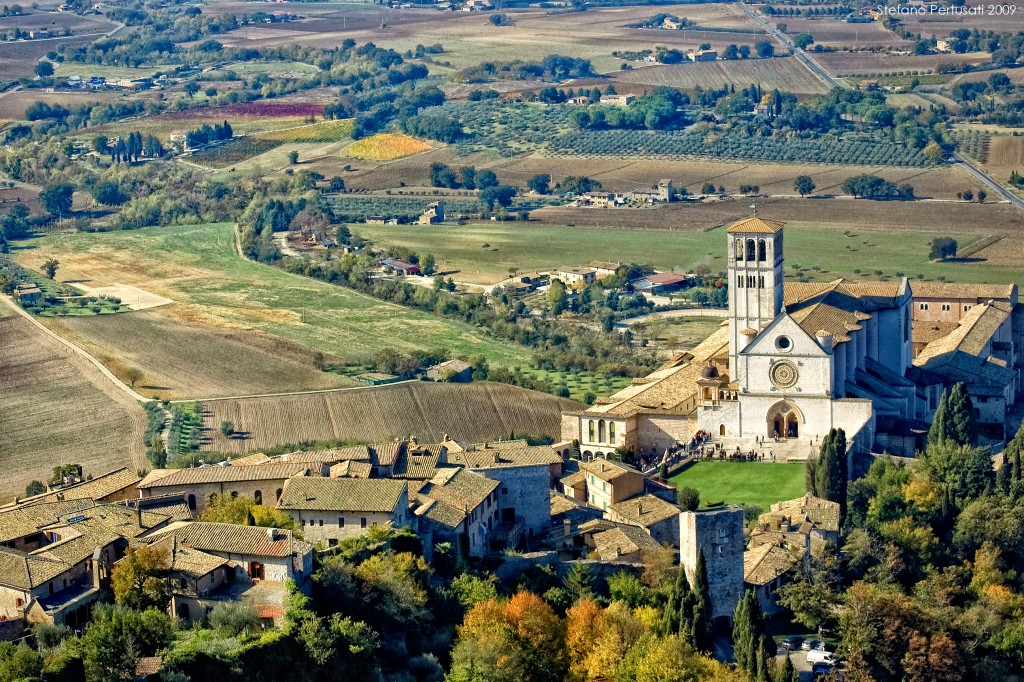
Basilica San Francesco, Assisi by Stefano Pertusani
Where
Umbria is landlocked and borders Lazio to the south, le Marche (the Marches) to the north and east, and Toscana (Tuscany) to the west. The colour of Umbria is green which covers its fertile pastures, mountains, hills, and valleys. Interspersed are yellow fields of sunflowers, their faces perpetually following the sun. Umbria’s landscape is crisscrossed by lakes and rivers. Umbria has many medieval cities and jazz and arts festivals in Spoleto.
Umbria is where both Perugina chocolates and Saint Francis of Assisi (the founder of a religious artistic movement expressed in Gothic art) originate.
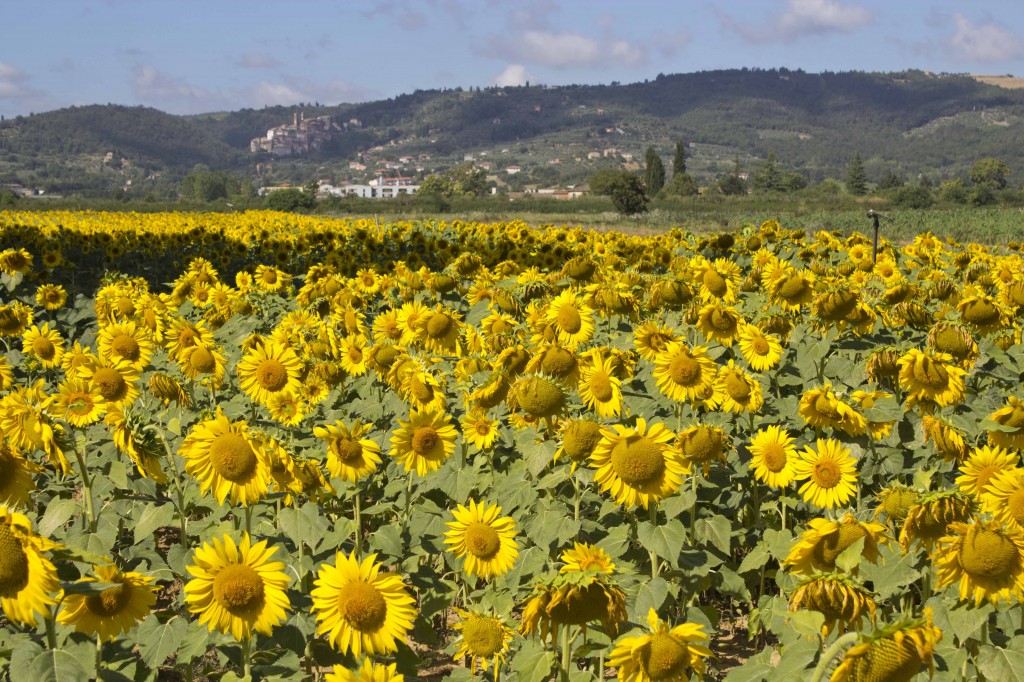
Sunflower field by Meimanrensheng
What to See
The walled medieval town of Assisi, the native city of St. Francis, should not be missed. In particular, see Giotto’s frescoes in the Basilica di San Francesco (a church and major destination in Italy for pilgrimage), the view from Rocca Maggiore (a 12th Century fortress) and the Gothic Chiesa di Santa Chiara (a 13th century church) and its views of the Umbrian countryside. Just outside Assisi, see the Eremo delle Carceri (a hermitage) and surrounding forest.
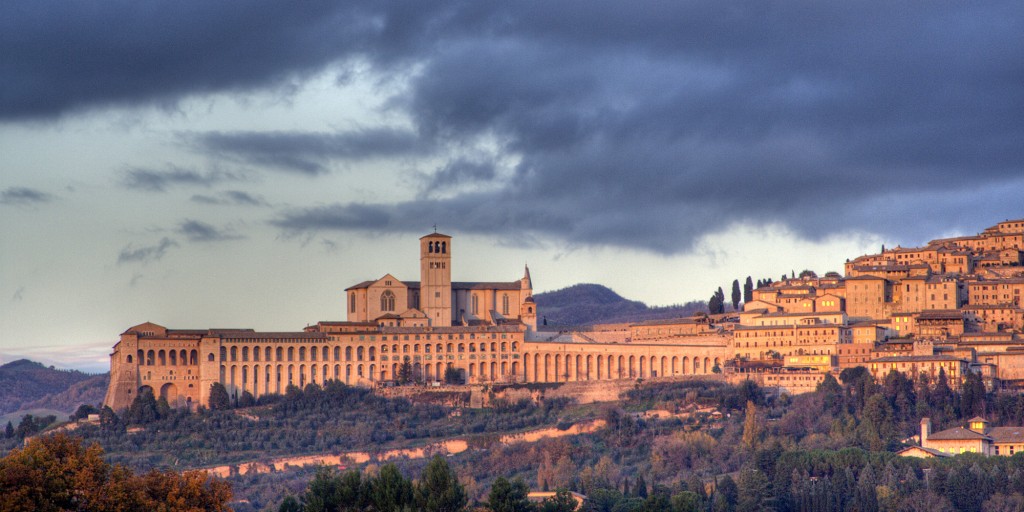
Assisi by Roberto Ferrari
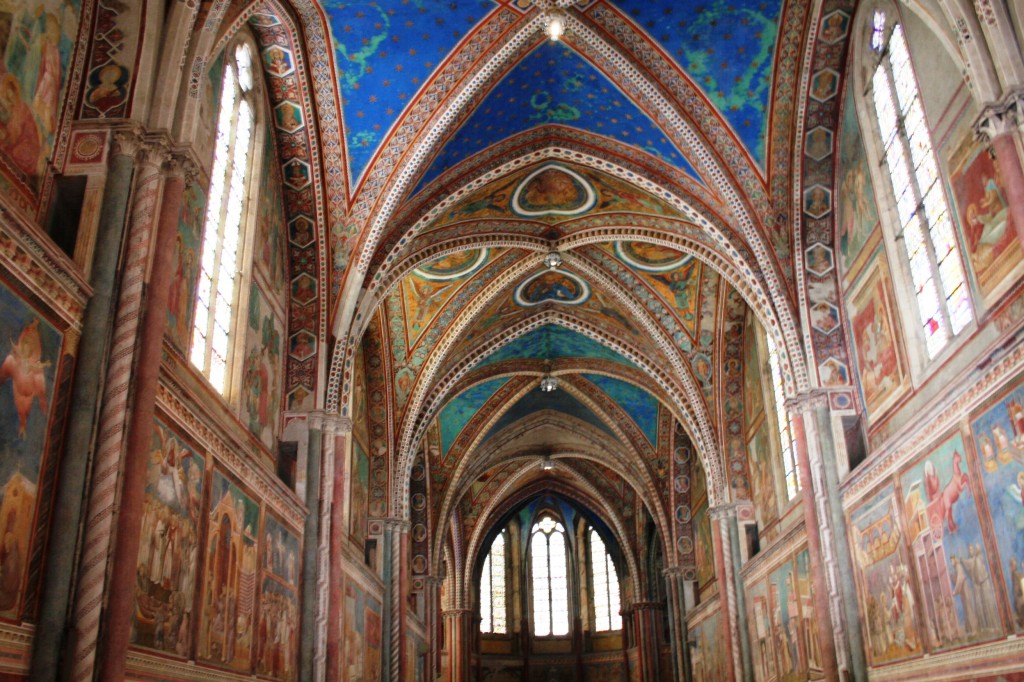
Basilica San Francesco, Assisi by B.Roveran
Another medieval town, Gubbio, has an attractive old town. Charming points of interest are the Piazza Grande and its Palazzo dei Consoli (a Gothic building), 20 Settembre Street, Galeotti Street, Via Piccardi Street, Baladssini Street, and dei Consoli street.
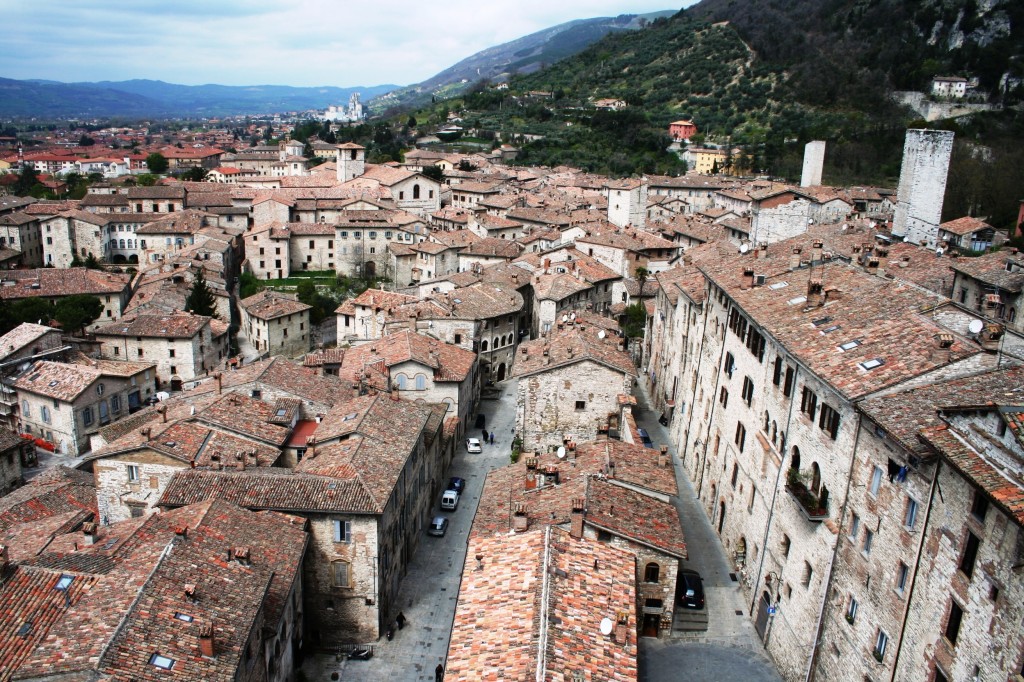
Gubbio by B.Roveran
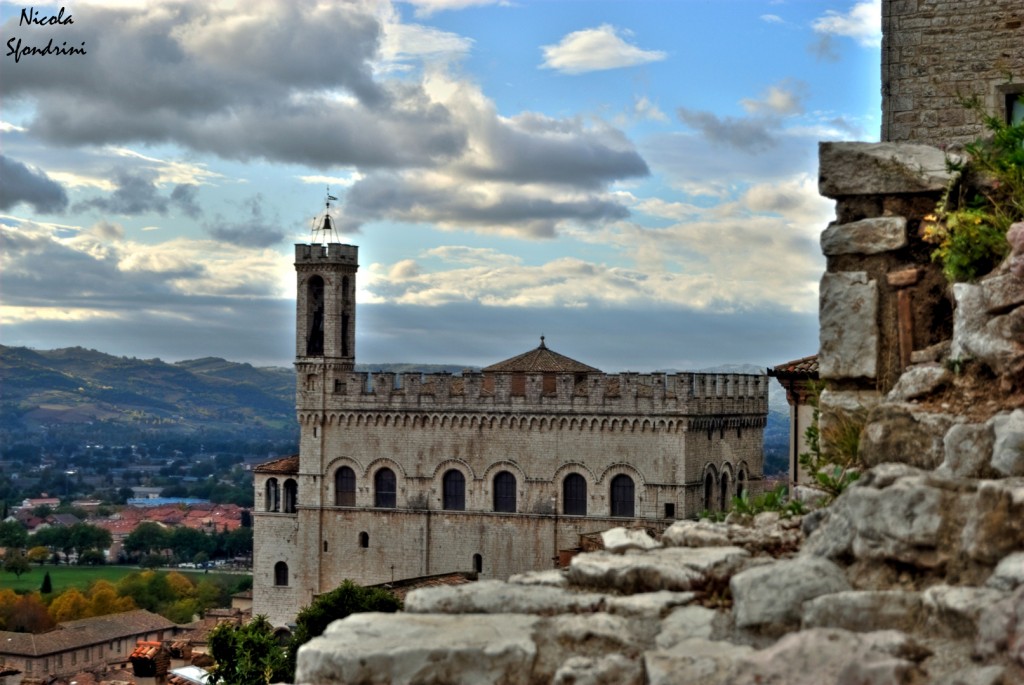
Palazzo di Consoli, Gubbio by Nicola Sfondrini
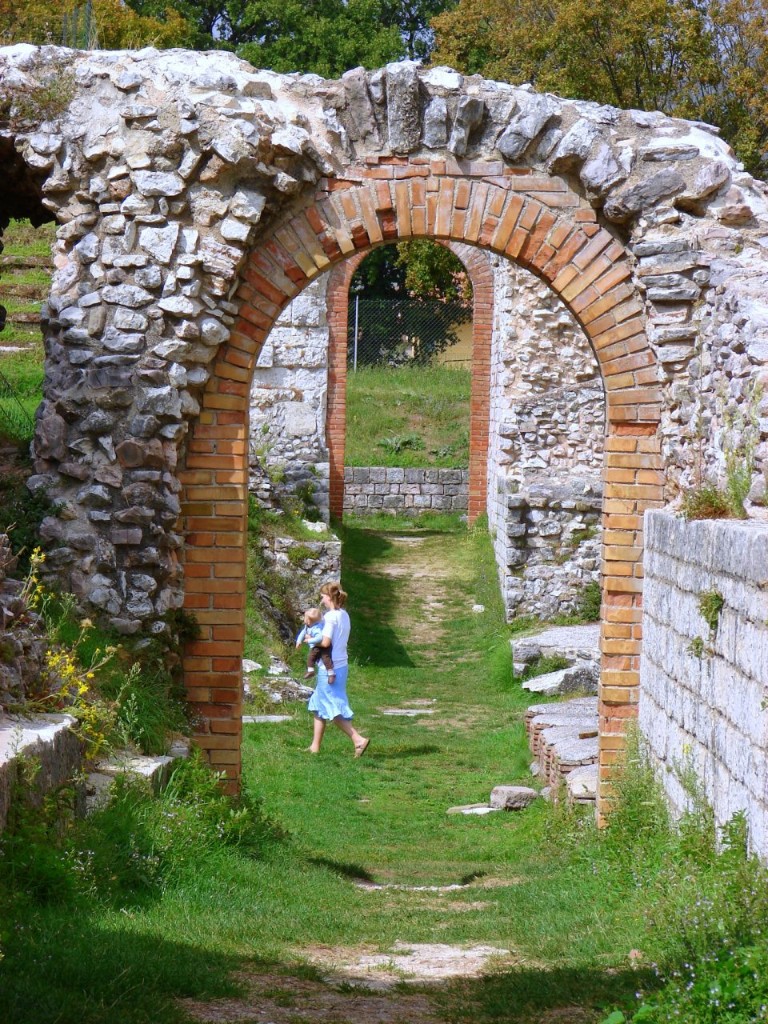
Theatre in Gubbio by La Fattina
The Etruscan built cities of Orvieto and Perugia (the capital of Umbria) sit on promontories and lovely places to visit. Orvieto is internationally famous for its white wine but the city has some beautiful Gothic buildings including the Duomo and Façade (including the frescoes inside). Orvieto also hosts the Umbria Jazz Festival in December. Spoleto hosts the Festival dei Due Mondi (the Festival of Two Worlds) which is a three week music and opera festival during June and early July.
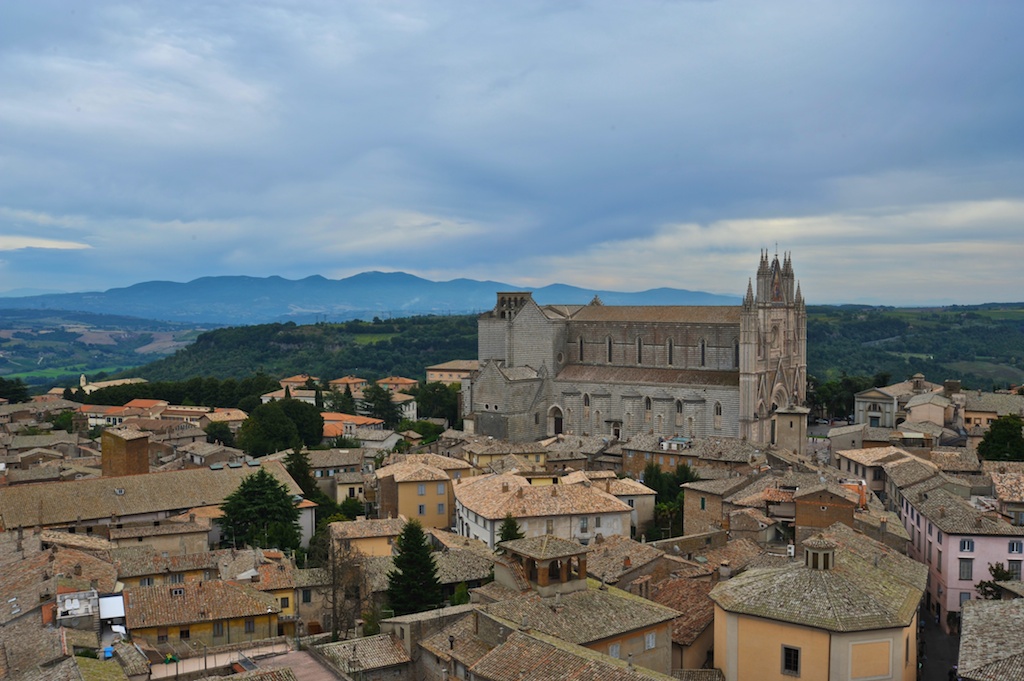
Orvieto by Maury Landsman
Perugia is probably best known internationally for its chocolates but it also has vibrant industrial and commercial sectors as well as a well-known university. The heart of Perugia is Piazza IV Novembre (the town square) and is considered one of the grandest in Italy. Sites to visit include the Fontana Maggiore (the Great Fountain), Palazzo dei Priori (the Prior’s Palace) and the Galleria Nazionale dell’Umbria (the National Gallery of Umbria on the top floor of the Prior’s Palace), the 10th century Chiesa di San Pietro (St. Peter’s Church), the Museo Archeologico Nazionale dell’Umbria (The National Archaeological Museum), and the 15th century Oratorio di San Bernardino (the Oratory of St. Bernardino), and Via dei Priori. Perugia hosts the world renowned Umbria Jazz Festival in July.
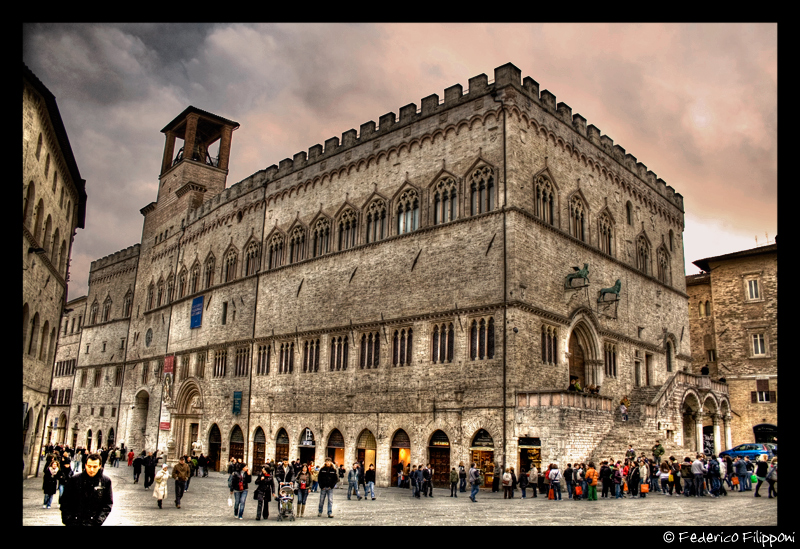
Palazzo di Priori, Perugia by Federico Filipponi

Fontana Maggiore, Perugia by Marcod69
Lago Trasimeno (Trasimeno Lake), most famous for a Roman battle against Hannibal and for their fish, is a scenic lake full of bird life and lovely little towns along its coast such as Castiglione del Lago and Passignano. From these towns there is a ferry which goes to an island, Isola Maggiore, which has a castle. This boat trip is a great day out for small children. Panicale is a medieval hillside town overlooking Lago Trasimeno.
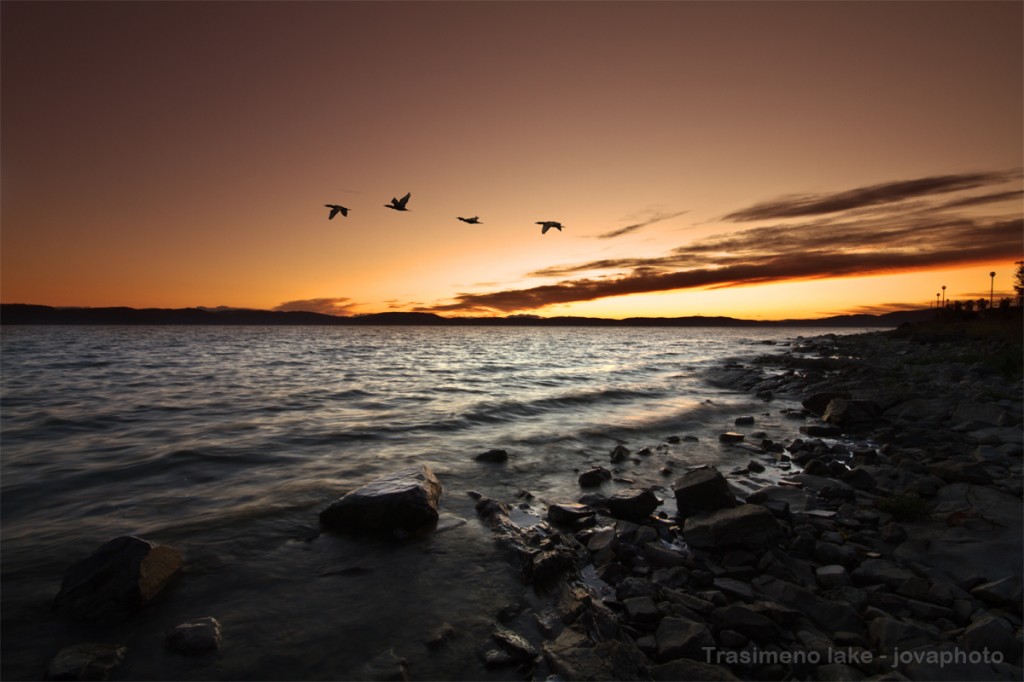
Lago Trasimeno by Giovanni Auricchio
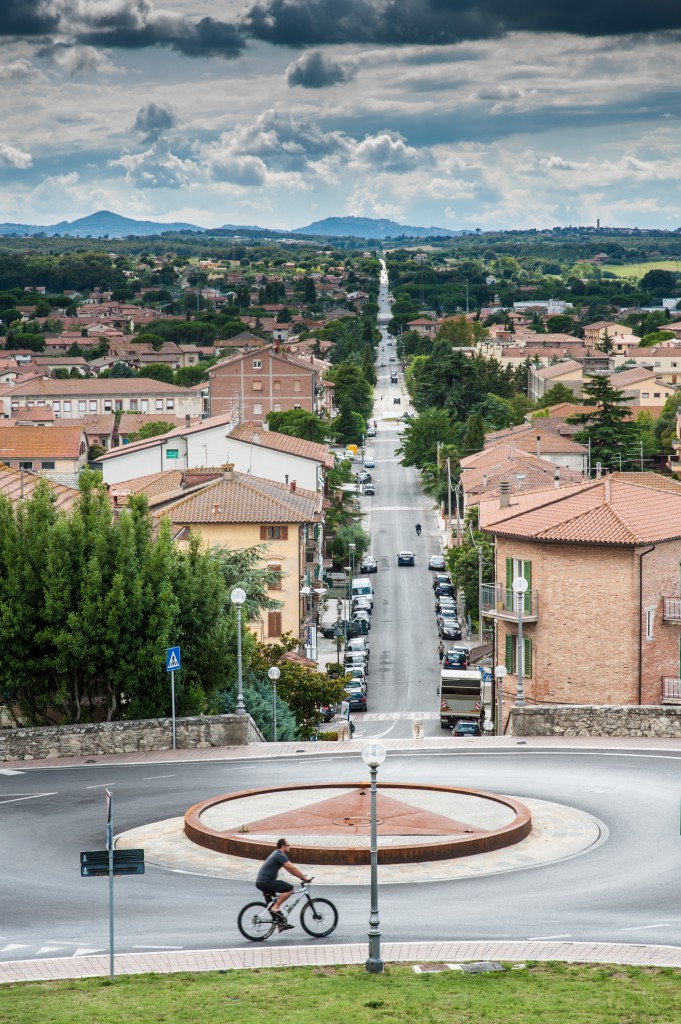
Castiglione del Lago by Hakon Sonderland
Another medieval town, Todi, has the enchanting Piazza del Popolo (a town square with many 13th and 14th century buildings on it) and the Gothic and Renaissance church (Chiesa di San Fortunato).
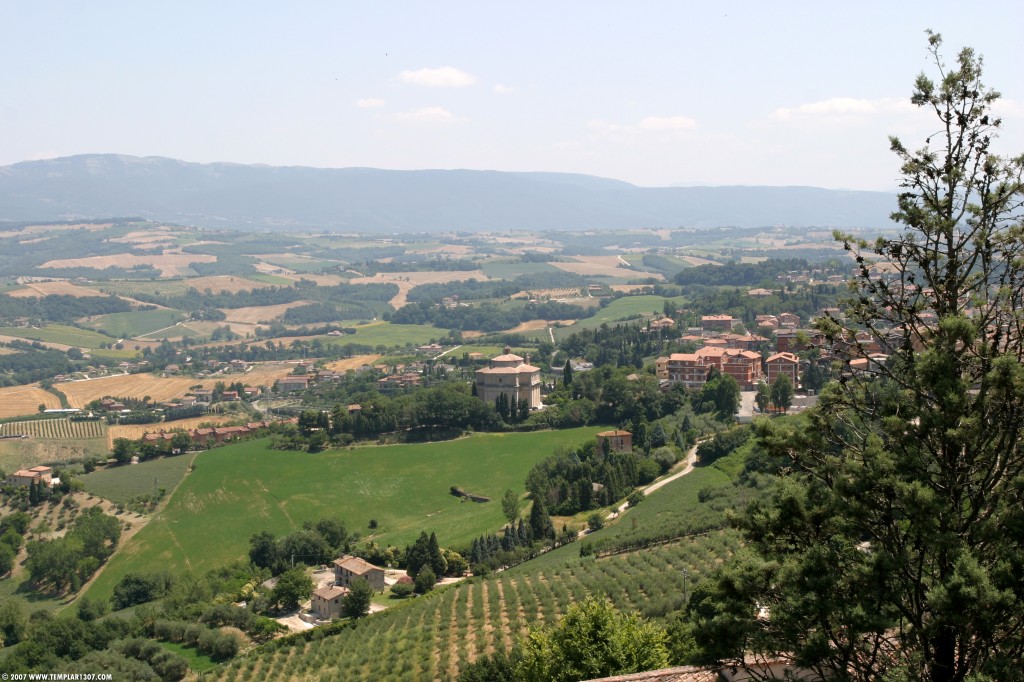
Todi by Benjamin
Two notable villages for any gourmet are Norcia and Castelluccio. Norcia is a walled town within the national park of Monti Sibillini which is famous for its highly skilled butchers. Castelluccio is a beautiful hillside village sitting at the highest elevation in the Apennines, next to Mount Sibillini National Park. The area is a destination for trekkers with gorgeous fields of red poppies and yellow rapeseed flowers as a stunning backdrop. Castelluccio is famous for its green brown lentils prized for their thin skin and tender consistency.
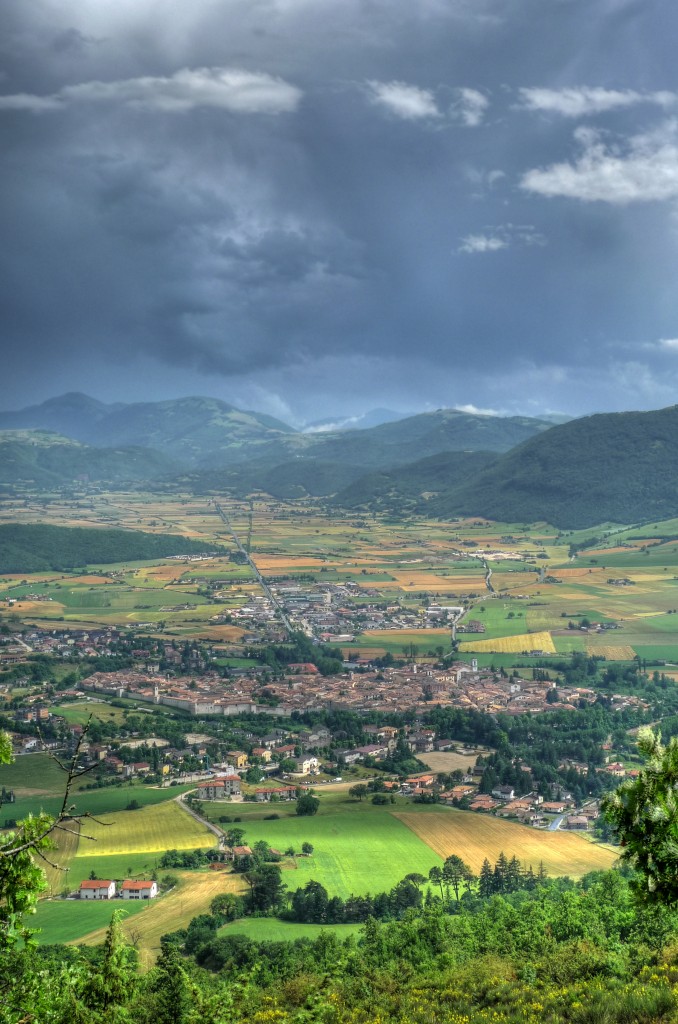
Norcia from the Strada della Muraglione by Rullo69
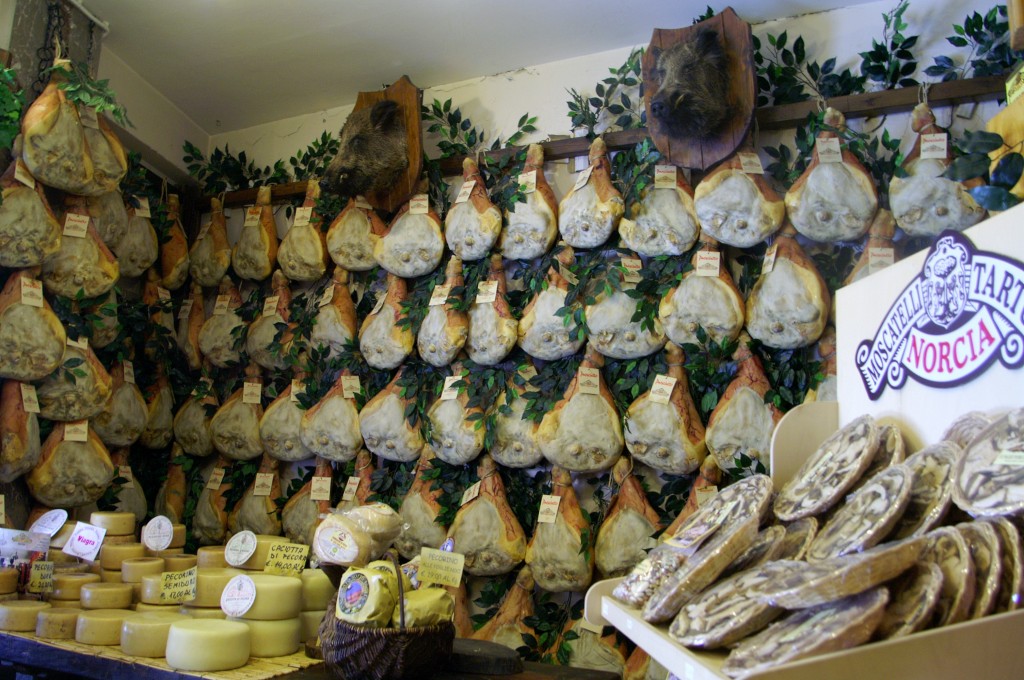
Salumi from Norcia by Tiemen Slingerland
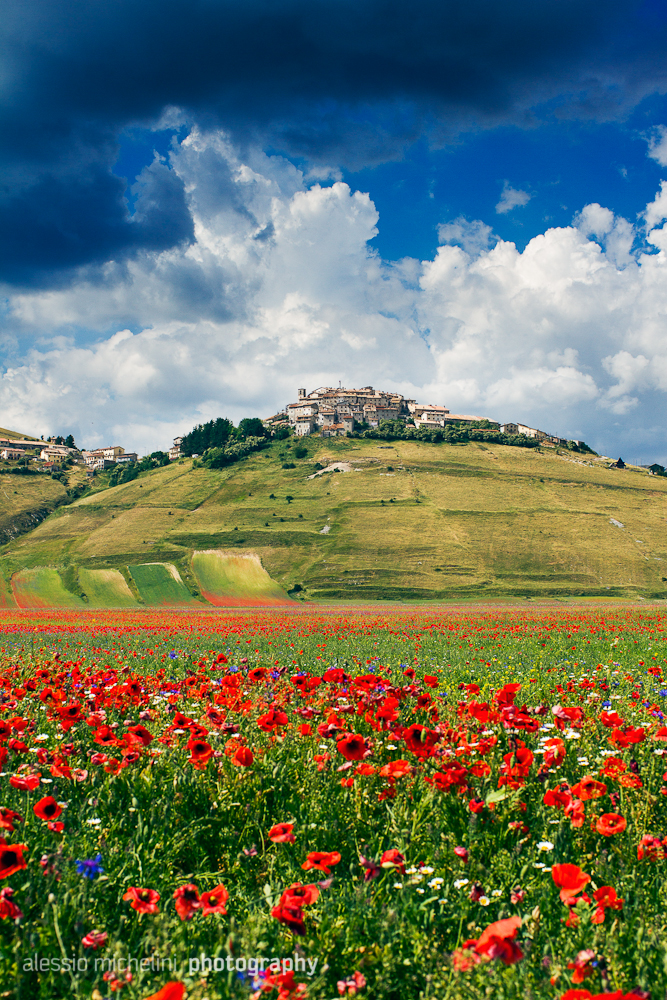
Castelluccio by Alessio Michelini
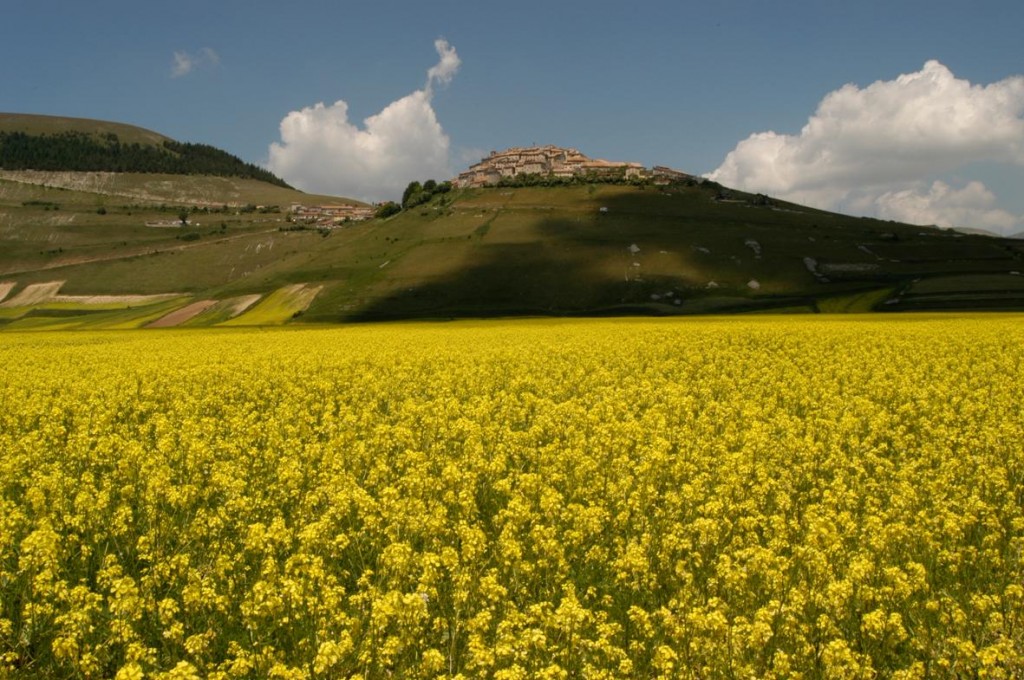
Castelluccio di Norcia (Monti Sibillini) by Falgraf
Other scenic villages to visit include: Arrone (a hillside village founded in the 9th century as a wooden castle overlooking the Nera river), Bevagna (a town famous for having one of the most beautiful town squares (Piazza Silvestri) in Italy, Citerna (a walled village rich with art and history with a complex medieval water system and walkway), Deruta (a village known as “old Perugia” which is famous for its ceramics and ceramics museum), Montefalco (a scenic village known for its wine and olive oil production), Montone (a walled medieval village), San Gemini (a village which has been famous for its mineral water since Roman times), and Torgiano (a well preserved medieval village which produces some good red wine and has a fine red wine museum).
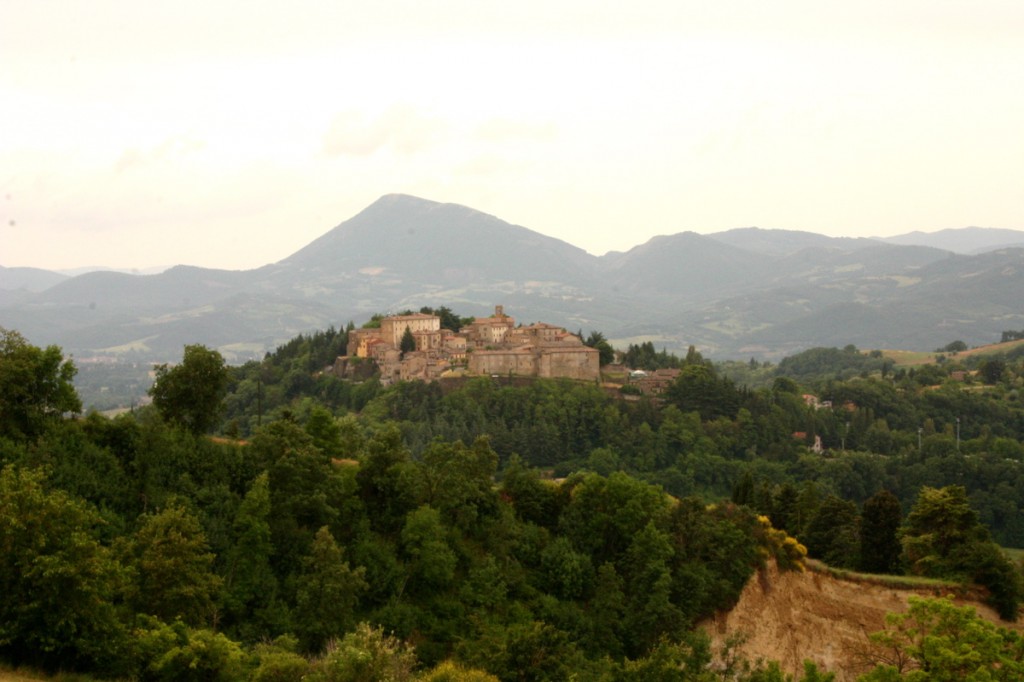
Montone by Denny Schmickle
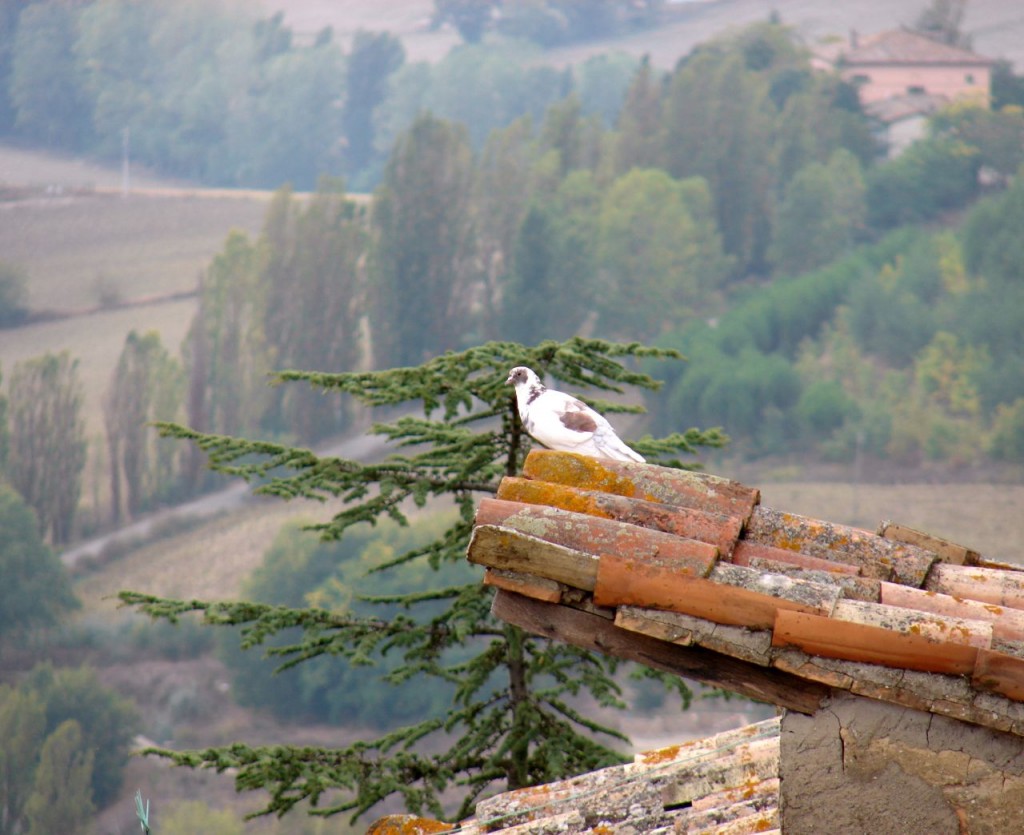
Bird over Montone by La Fattina
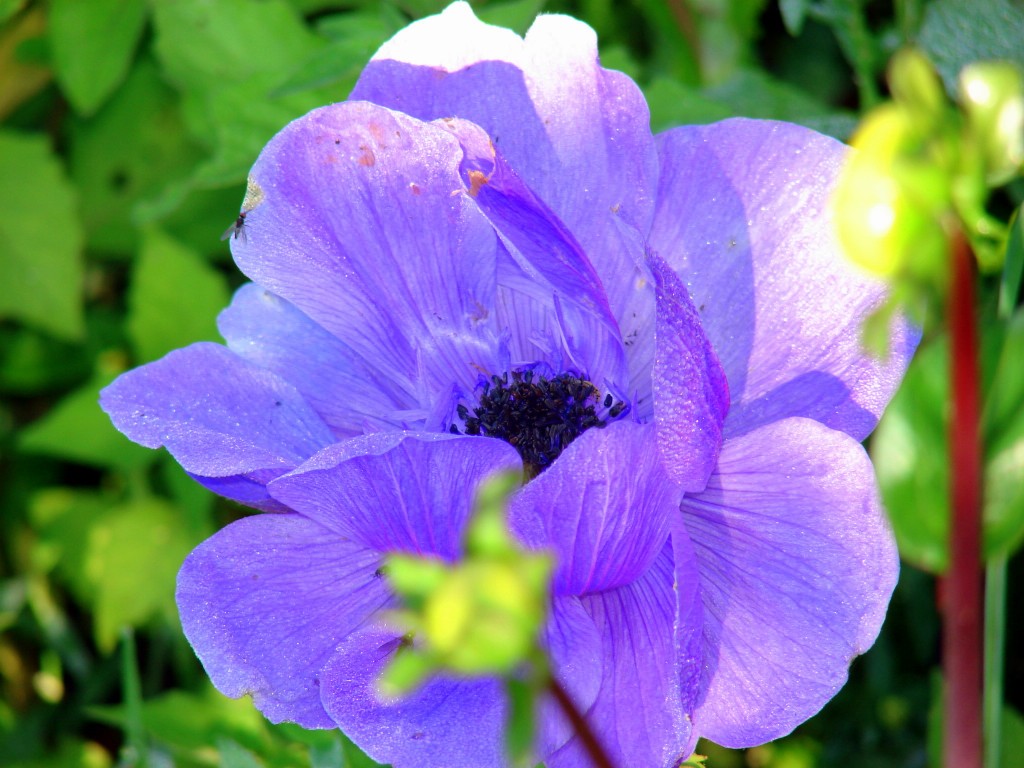
Anemone by La Fattina
Bring home olive oil, black and white truffles, ceramics from Deruta, lentils from Castelluccio, and Perugina chocolates.
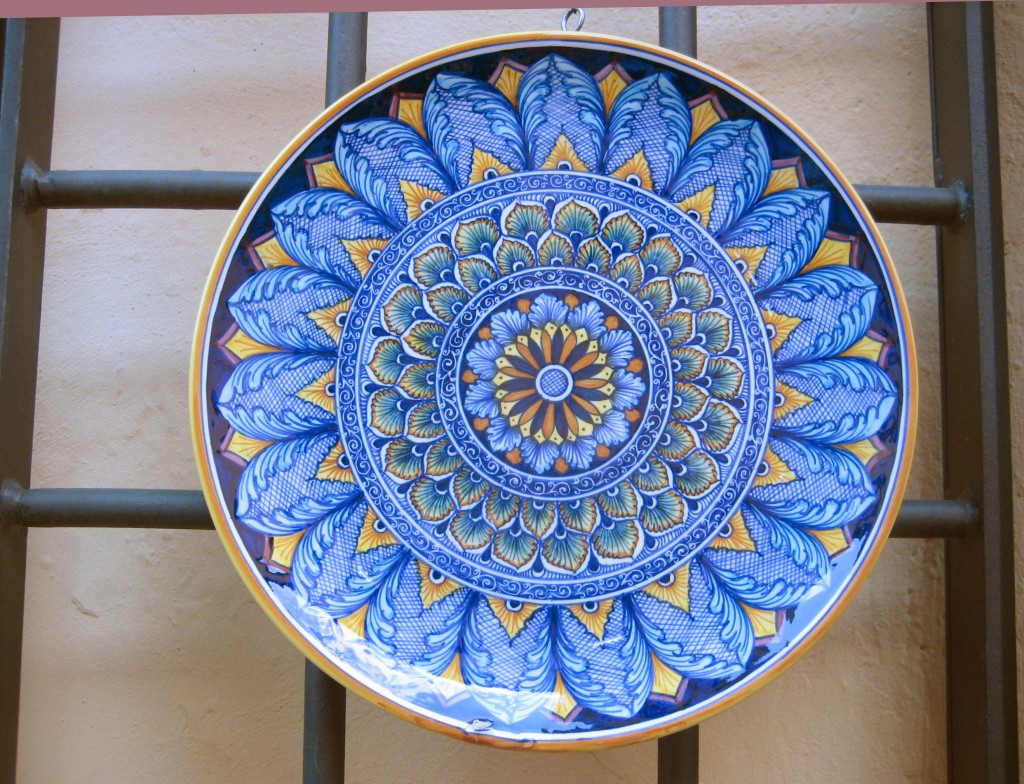
Deruta pottery by Barbara Skinner
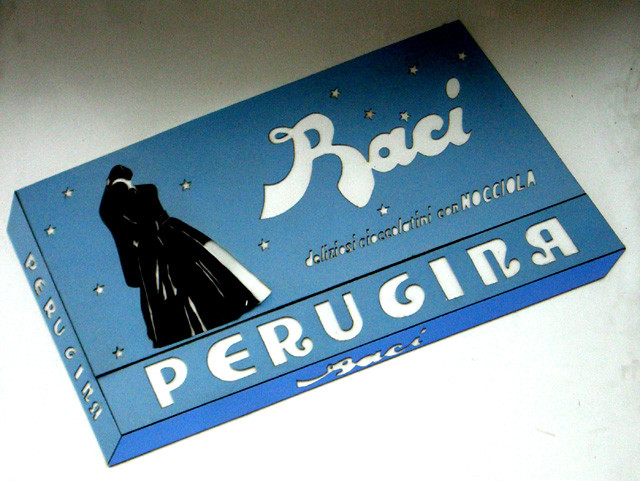
Perugina Baci by Smeerch
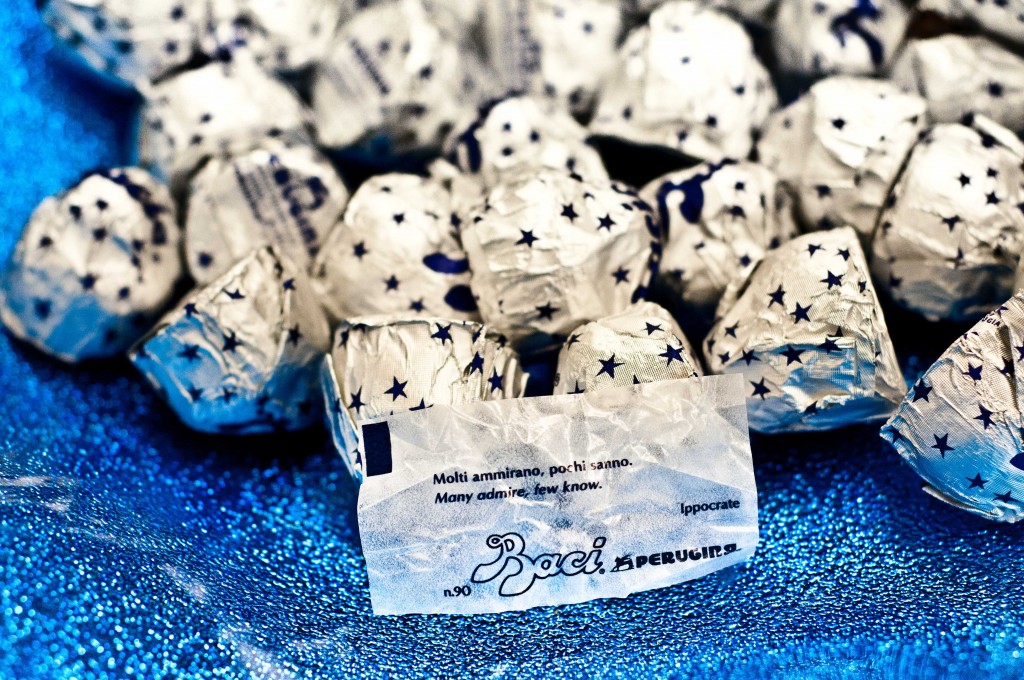
Baci by Jeanette
Visit:
Antica Norcineria Fratelli Ansuini
Via della Stazione 06046, Norcia (Perugia) Tel: +39 0743 816 806 http://www.fratelliansuini.com/An artisan butcher where you can buy local salami, sausages, ham, olive oil, and cheese.
Spoleto’s music festival:
The Festival dei Due Mondi (Festival of the Two Worlds) has held a music and opera festival each June to early July for the past 55 years. It is called the Festival of Two Worlds as it has a sister festival in Charleston, South Carolina in the United States.
http://www.festivaldispoleto.com/
Orvieto’s Umbria Jazz Festival
The Umbria Jazz festival hosts world famous jazz musicians from all over the world who perform for four days in December in Orvieto’s historic buildings including the Duomo (cathedral).
Perugia’s Umbria Jazz Festival
Perugia has hosted the Umbria Jazz Festival for forty years and it is one of the world’s most important jazz festivals. Jazz greats such as B.B. King, Miles Davis, Dizzy Gillespie, and Sarah Vaughan have all performed. The festival takes place each July and lasts for 10 days.
The Larder
Two iconic ingredients from Umbria are black truffles and pork, both of which feature in many of the regional dishes. Black truffles are usually grated or chopped rather than thinly sliced like the white truffles in north. Truffles are not often found in the shops. Rather they are easier to procure by asking around at bars and restaurants until someone rings a truffle hunting friend to come.
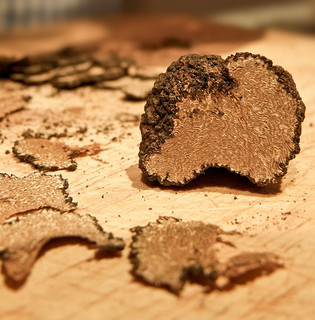
Black truffle by Rei-San
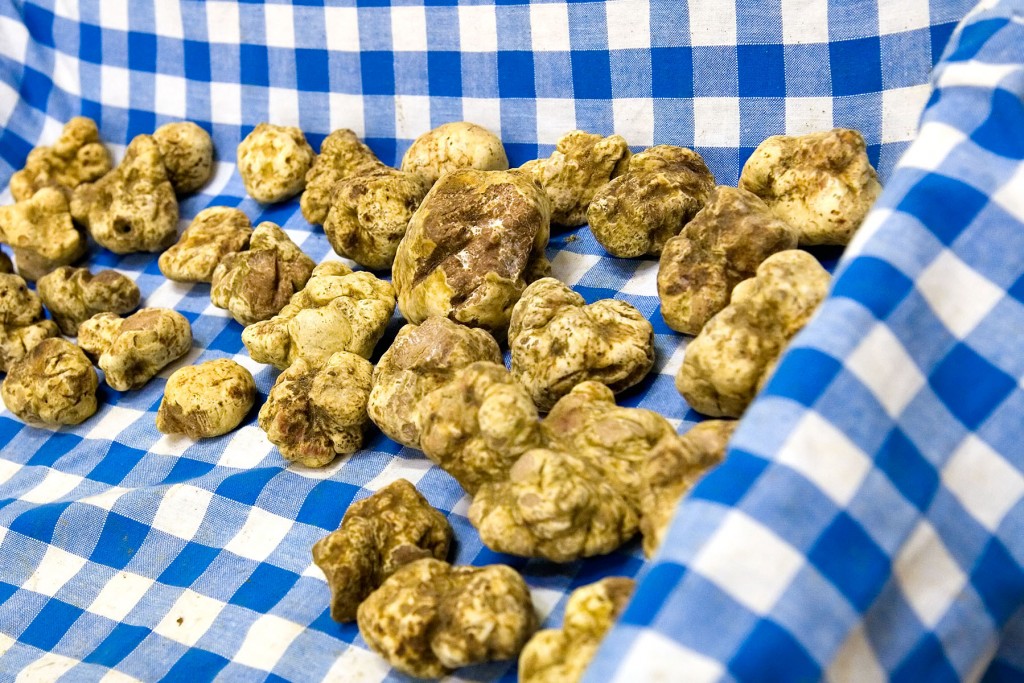
White truffles by Fulminating
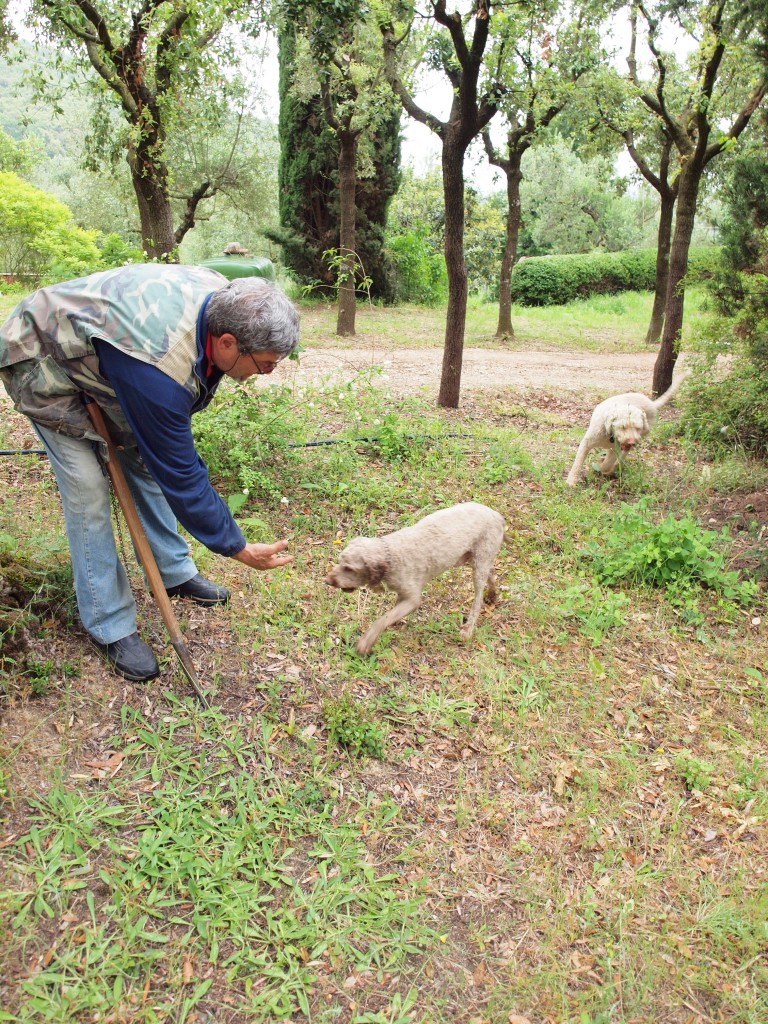
Truffle hunting dogs by Elisabets
The fine pork from Umbria, traditionally free range and fed on black truffles and herbs, continues to be high quality. Butchers from this region are famed for their skill and historically also worked as surgeons. The norcini, butchers from Norcina, are famous across Italy for their cured pork products.
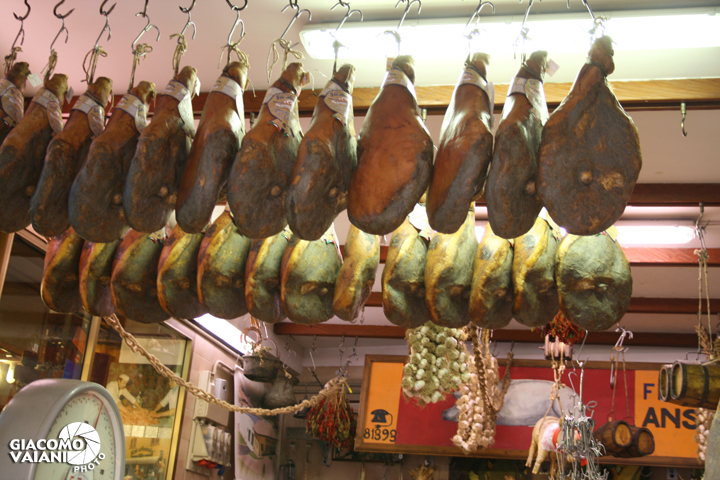
Prosciutto by Giacomo Vaiani
Grains, particularly emmer wheat, and pasta, such as stringozzi, cariole, or manfrigoli, are typically Umbrian. Lentils from Castelluccio are world famous for their mineral flavour.
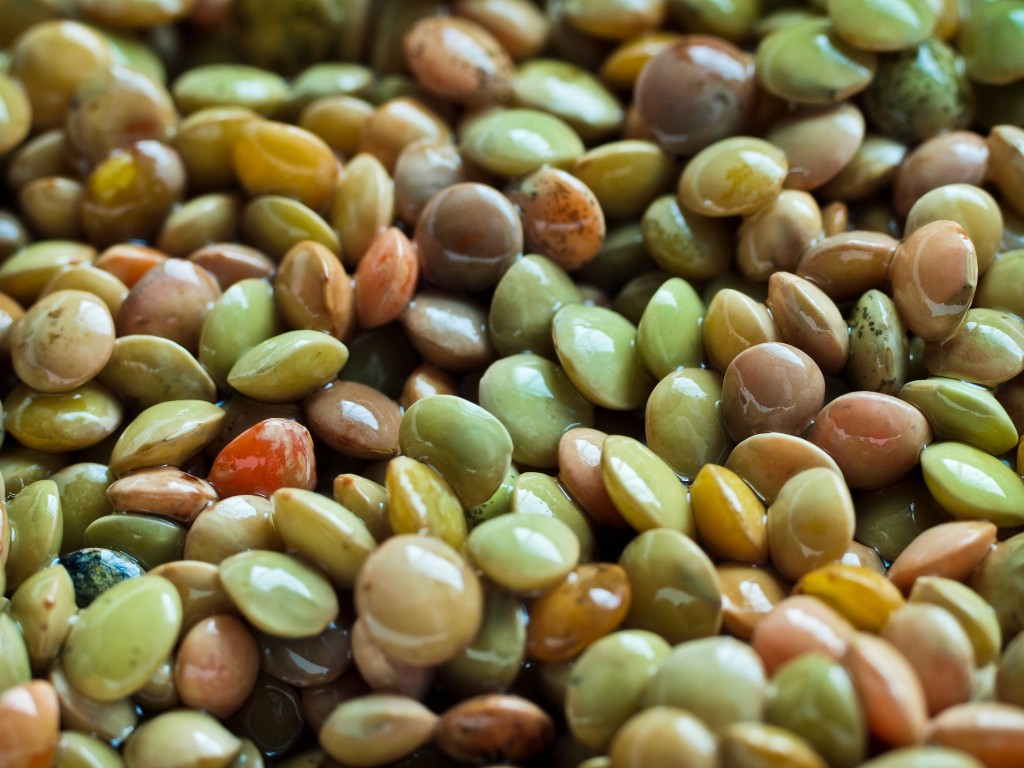
Lentils by Luca Boldrini
The lake provides trout, carp, tench, pike, eels, and freshwater prawns.
Other typical ingredients include almonds, pennyroyal, rosemary, wild rocket, hop shoots, wild mustard, poppy, clematis, onions, mushrooms, garlic, fennel, asparagus, game birds (thrush, partridge, and wood pigeons), hare, rabbit, beef, kid goat, veal, hare, capon, and lamb.
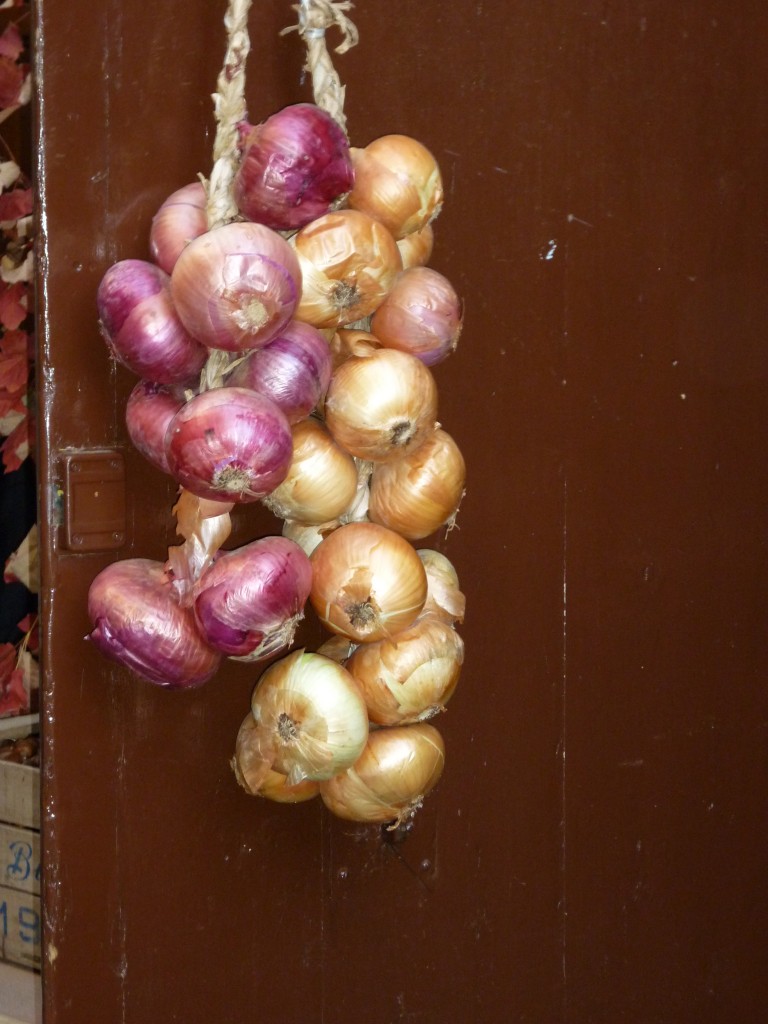
Onions from Montone by cocla51
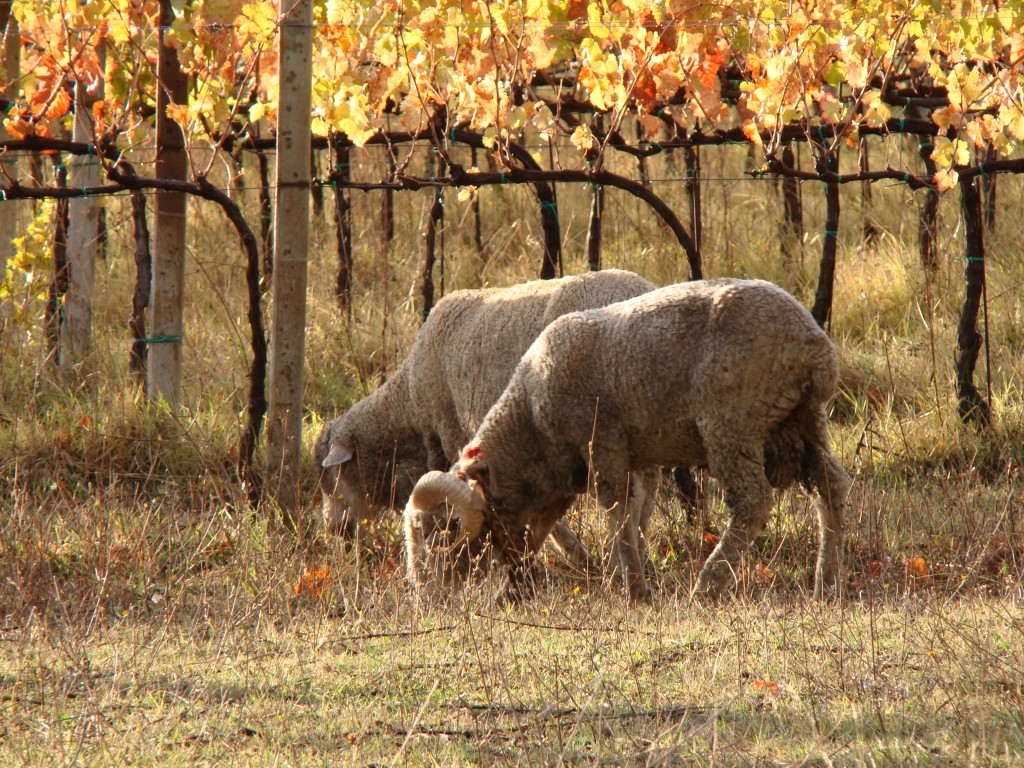
Sheep by La Fattina
Menu
The cuisine here is natural, seasonal, and simple but flavourful. Most dishes have only a handful of ingredients and meats such as beef, pork, chicken, pheasant, guinea hens, thrush, and wood pigeons are often spit-roasted, boiled, grilled, or baked in a wood oven with aromatic woods and embellished only with local olive oil. They are able to cook simply because they are careful to use the best ingredients, regardless of cost. They are considered lavish because they use the same ingredients, no matter how expensive, for everyday meals as well as for special celebrations. For Umbrian recipes, see here.
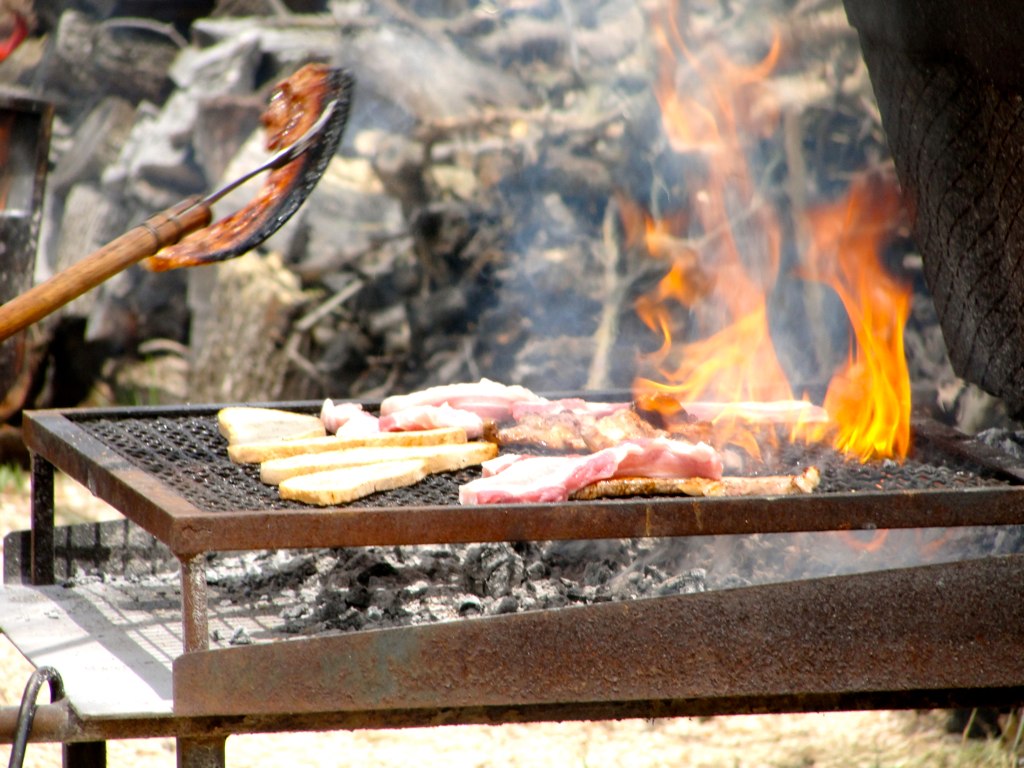
Barbecue in Montefalco by Umbrialovers
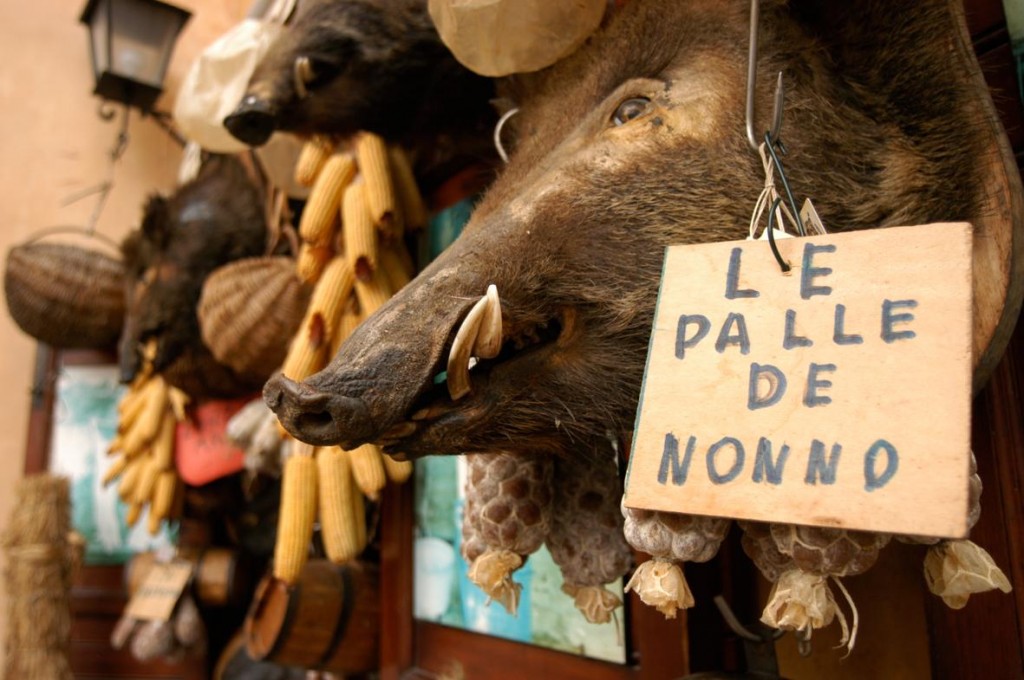
Wild boar head by Falgraf
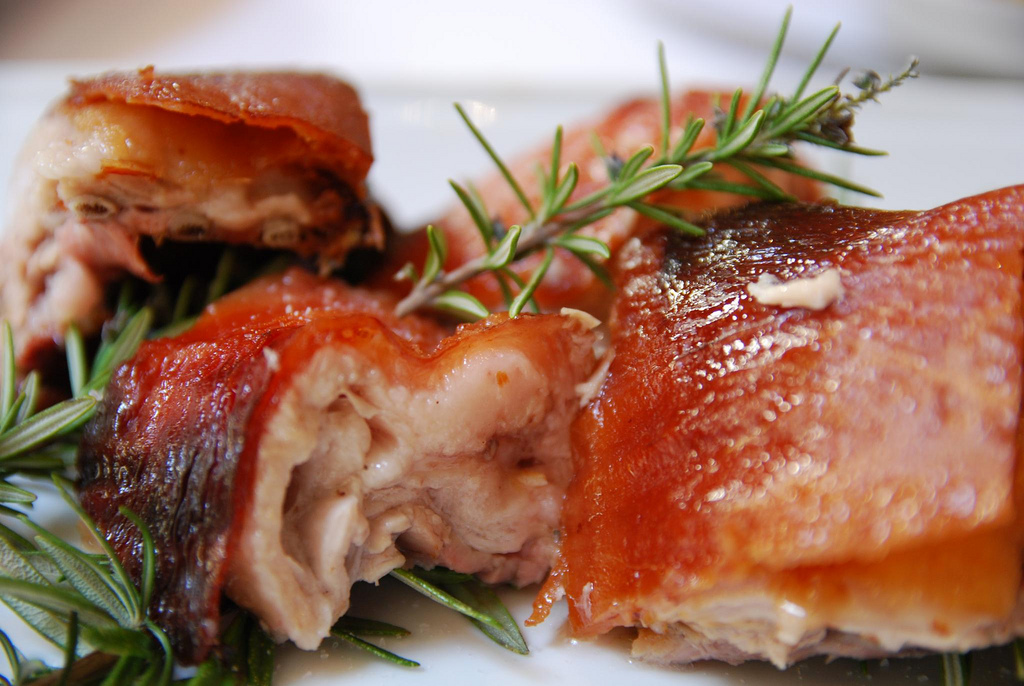
Roast suckling pig by Alpha
The most famous meat dish from Umbria is porchetta (slow-roasted wild suckling black pig, stuffed with fennel, innards, and garlic). There are many local dishes described as “alla norcina” which indicates the use of black truffles. Truffles, despite their cost and rarity, in Umbria are pounded together with garlic and anchovy and are used to dress pasta, spread on hot grilled bread, in meat sauce, to top pizza, and to make an omelette. See recipes here.
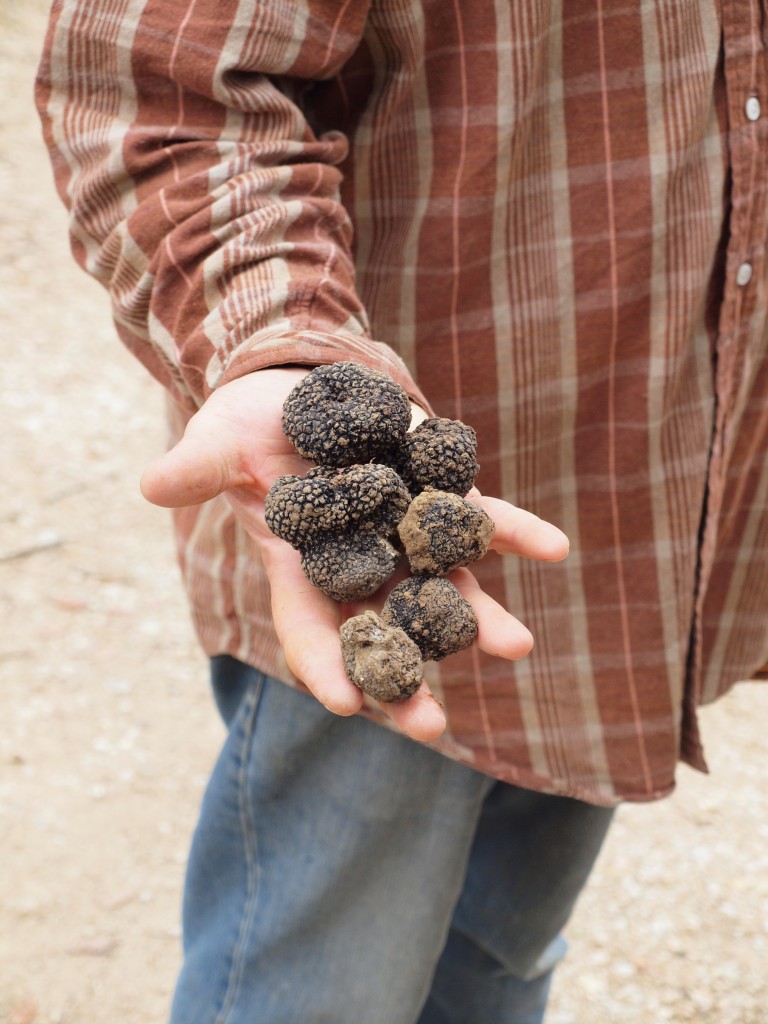
Truffle hunting by Elisabets
Local wines to drink include white wines which are blended but include Trebbiano/Procanico grapes from Orvieto Classico, Colli Martani and Torgiano and red wines made from Sangiovese grapes from Torigiano. There is also excellent Sagrantino di Montefalco and Montefalco red wine produced by Arnaldo Caprai. Producers of white wines to look for include Arnaldo Caprai, Barberani, Antinori’s Castello della Sala, Palazzone, and Tenuta Le Velette. Lungarotti is a red wine producer from Torgiano to look for. Another good producer of red wine is Antonelli.
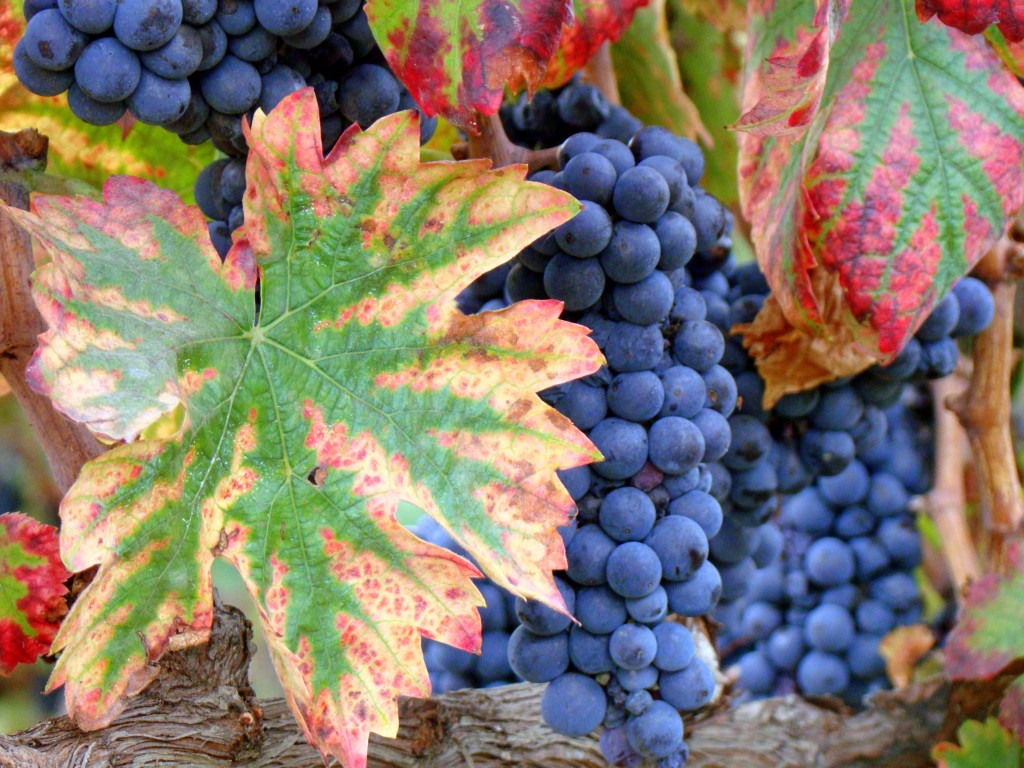
Winery by La Fattina

Grapes by Il Baro
Umbria also produces sweet wines such as a botrytis sweet wine from Orvieto. A good producer is Barberani. Another excellent sweet wine is the passito wine made from Sagrantino di Montefalco. Try producers such as Caprai, Adanti, Bea and Antonelli.
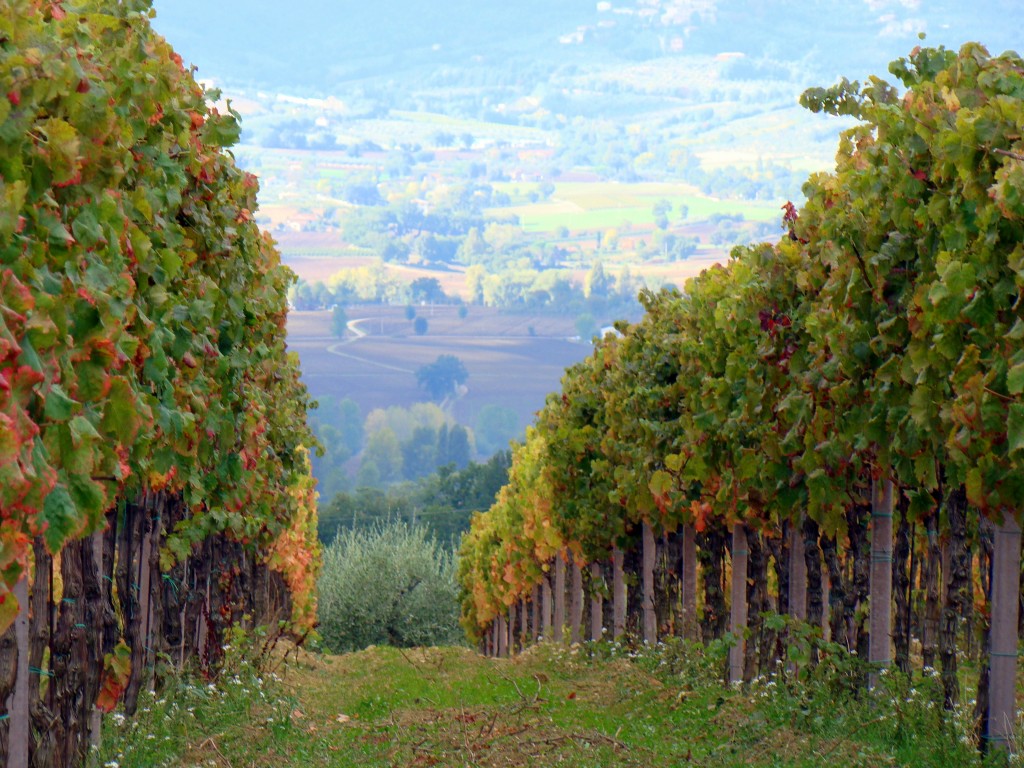
Winery by La Fattina
More relevant articles:
What to Eat
Typical local dishes in Umbria include (the most classic are written in bold):
Pane (Bread)
Torta di formaggio / Torta di Pasqua (a tall yeasted bread baked with cheese, served at Easter)
Salume (Cold Cuts)
Many of the salumi are named after their place of origin and have been made since ancient times.
Barbozza (cured, pig’s cheeks flavoured with garlic, salt, and pepper)
Corallina di Norcia (long pork and prosciutto salami with chunks of fat and flavoured with black peppercorns, wine, and garlic and lightly smoked with juniper berries)
Mazzafegato (pork liver salami flavoured with either orange zest, pine nuts, raisins, and sugar or salt, black pepper, and pine nuts)
Mortadella umbra (a flat pork salami with a strip of fat in the centre)
Prosciutto di Norcia PGI (prosciutto, sometimes lightly smoked)
Salami di tartufo (white truffle flavoured pork salami)
Salami di cinghiale (wild boar salami)
Antipasti (Starters)
Arvoltolo (fried dough, served with cold cuts)
Baggiona / Bagiana (soup made from broad beans, tomato, and basil, sometimes with sausage and chard)
Bruschetta (grilled bread rubbed with garlic and drizzled with olive oil)
Fagioline del Lago Trasimeno (multi-coloured beans eaten with olive oil or tomato and garlic, grown near Lake Trasimeno)
Pizza di Pasqua / Pizza al formaggio (cheese bread, served with salami and hard-boiled eggs)
Ricotta fritta (deep-fried breaded ricotta cheese)
Schiacciata / Crescia al testo (flatbread with either: olive oil, onions, omelette, cheese and salami, or greens and herbs)
Schiacciata con la cipolla (flatbread topped with sage and onion, sometimes with eggs or pecorino cheese)
Torta al testo / Panaro / Crescia / Ciaceia (thick flatbread baked on griddle, served with salami or vegetables)
Primi (First Courses)
Minestra di farro (emmer wheat, tomatoes, celery, carrot, parsley, pancetta, prosciutto bone, onion, and ham or vegetable broth soup, served with pecorino cheese)
Picchiarelli / Picilumbricelli / Stringozzi / Strangozzi (a fresh, eggless long pasta served with tomato sauce, black truffles or sausage and mushroom sauce)
Spaghetti alla norcina (spaghetti pasta with black truffle and garlic)
Tagliatelle con salsiccia, fegatini, funghi e tartufo nero (fresh tagliatelle pasta served with a sauce of sausage, chicken livers, mushrooms, and black truffle)
Secondi (Main courses)
Anguilla alla maniera di cascia (eel with olive oil, vinegar, bay leaf, rosemary, garlic, and breadcrumbs)
Anguilla in umido (stewed marinated small eels with salt, lemon, garlic, onions, parsley, salt, pepper, and white wine, finished with tomato sauce)
Capitone (spit-roasted eel with oil, vinegar, salt and bay leaves)
Costarelle (grilled poached pork chop)
Frittata con le vitabbie (vitalba (old marisjoy) omelette)
Frittata con i tartufi (black truffle omelette)
Gobbi alla perugina (baked deep-fried cardoons with meat sauce)
Lepre alla olive (hare with herbs, white wine, and olives)
Palomba alla ghiotta / Palomba alla leccarda (spit-roasted wood pigeon with bay leaves and prosciutto, served with toast and a sauce of roasting juices, oil, wine, prosciutto, sage, garlic, capers, and anchovy)
Palombe all’umido nero (spit-roasted wood pigeon, served with a sauce made from wood pigeon head and wings, garlic, cloves, black pepper, onion, sage, rosemary, olive oil, vinegar, black olives, and lemon zest)
Pollo alla cacciatora (stewed chicken with tomatoes)
Pollo in porchetta (spit-roasted chicken stuffed with pennyroyal, rosemary, and garlic)
Porchetta (spit-roasted wild suckling pig, stuffed with its organs, fennel, and garlic)
Regina in porchetta (roasted carp marinated with ham fat, herbs, garlic, salt and pepper, served with olive oil and lemon juice)
Salsiccia all’uva (pan-fried pork sausage finished with grapes)
Tegamaccio (soup of eel, pike, perch, and tench, served on toasted bread)
Contorni (Side dishes)
Bandiera (stewed peppers with onions, basil, and tomatoes)
Colcigli (a local vegetable similar to spinach)
Lentichie di Castelluccio PGI (lentils)
Dolci (Desserts)
Arvoltolo / Brustengo (fritters served with sugar, honey, or jam)
Brustengolo (cake-like bread made with cornmeal, olive oil, sugar, pine nuts, walnuts, hazelnuts, raisins, apples, lemon zest, and anise liqueur)
Cialde / Panicocoli (thin cookies cooked on an iron press)
Ciaramicola (ring -shaped lemon flavoured cake with a cross in the centre, topped with meringue and confetti sugar, traditionally offered to bethrothed brides)
Cicerchiata dolce (fried sweet lemon flavoured dough balls coated in honey and built into a pyramid or ring)
Crescionda (cake made with amaretti biscuits, crushed rusks, and lemon zest)
Fave di morti (almond cookies)
Pan nociato / Pannociato (sweet bread with pecorino cheese, butter or olive oil, raisins, dates, figs, lemon zest, and walnuts)
Pan pepato / Pam pepato (cake made with cooked wine must, cocoa, honey, candied fruits, black pepper, walnuts, almonds, and raisins)
Pinoccate (pine nut caramelized sugar cakes, served on wafers wrapped in paper at Christmas, sometimes made with meringue, almonds, and sugar)
Serpentone / Torciglione (a fresh and dried fruit cake shaped like a snake)
Striccheti (spherical almond cakes cooked on a wafer base)
Formaggi (Cheeses)
Pecorino di Norcia (hard, pasteurized ewe’s milk cheese treated with olive oil)
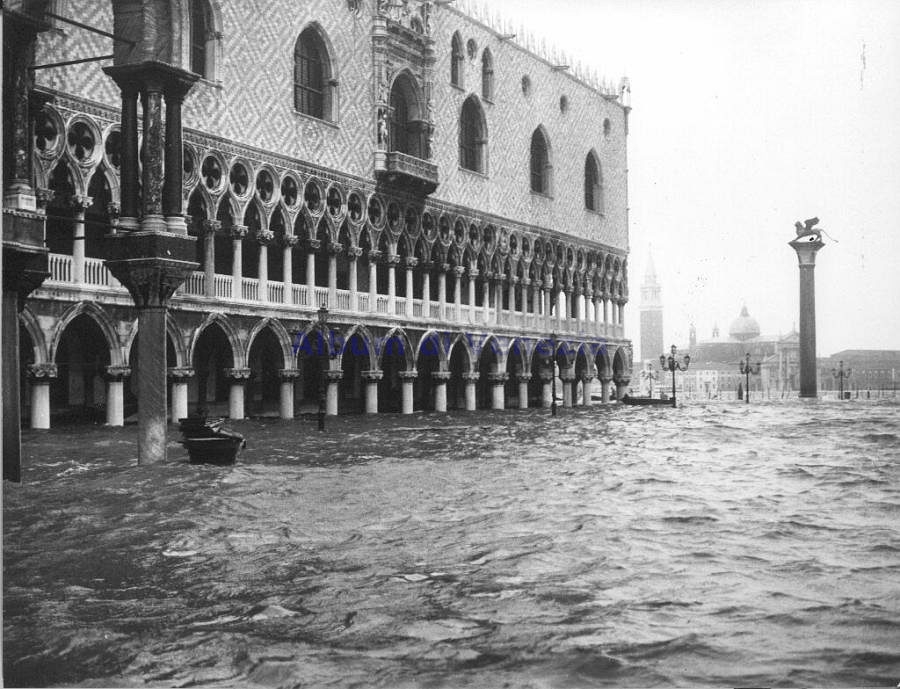
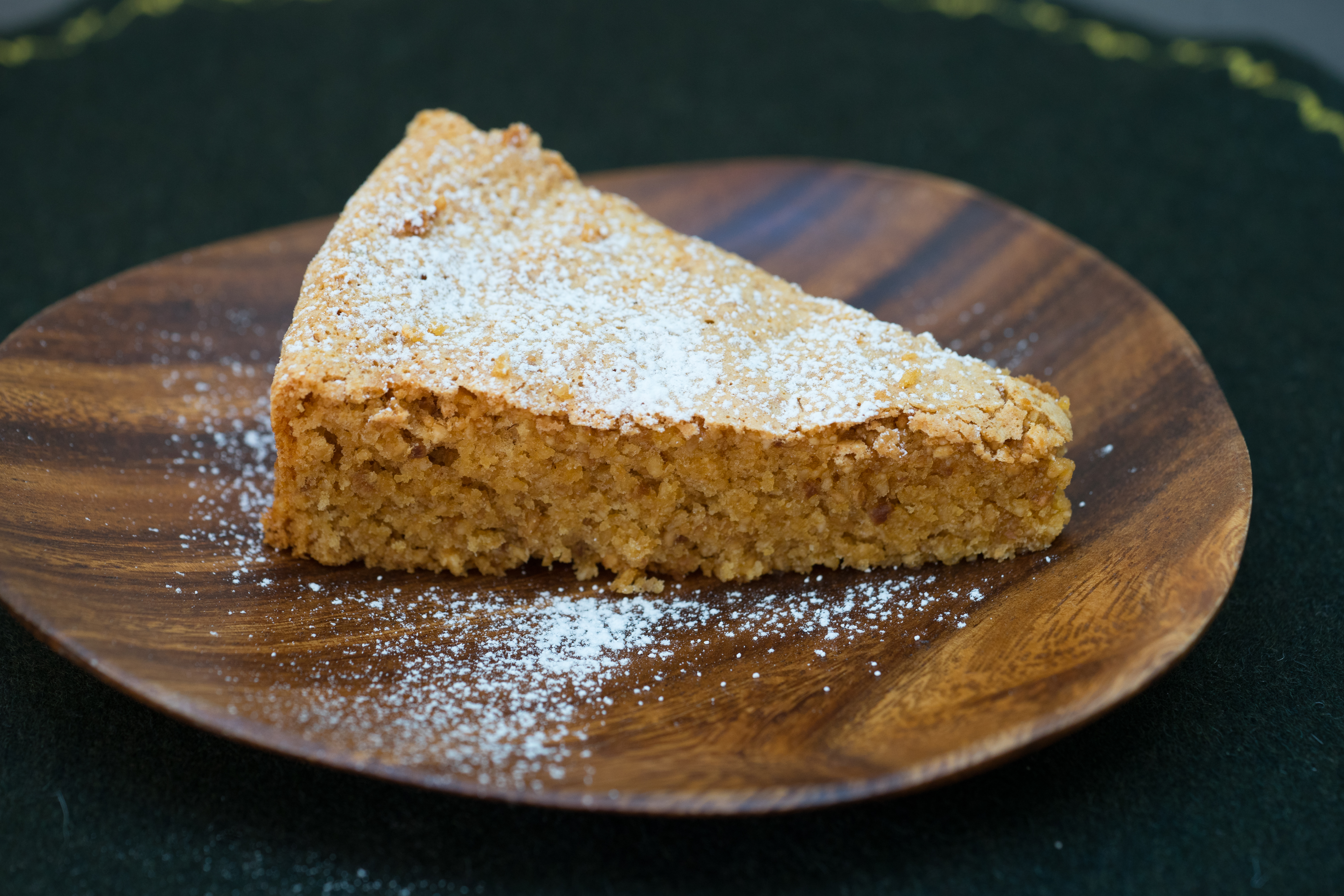
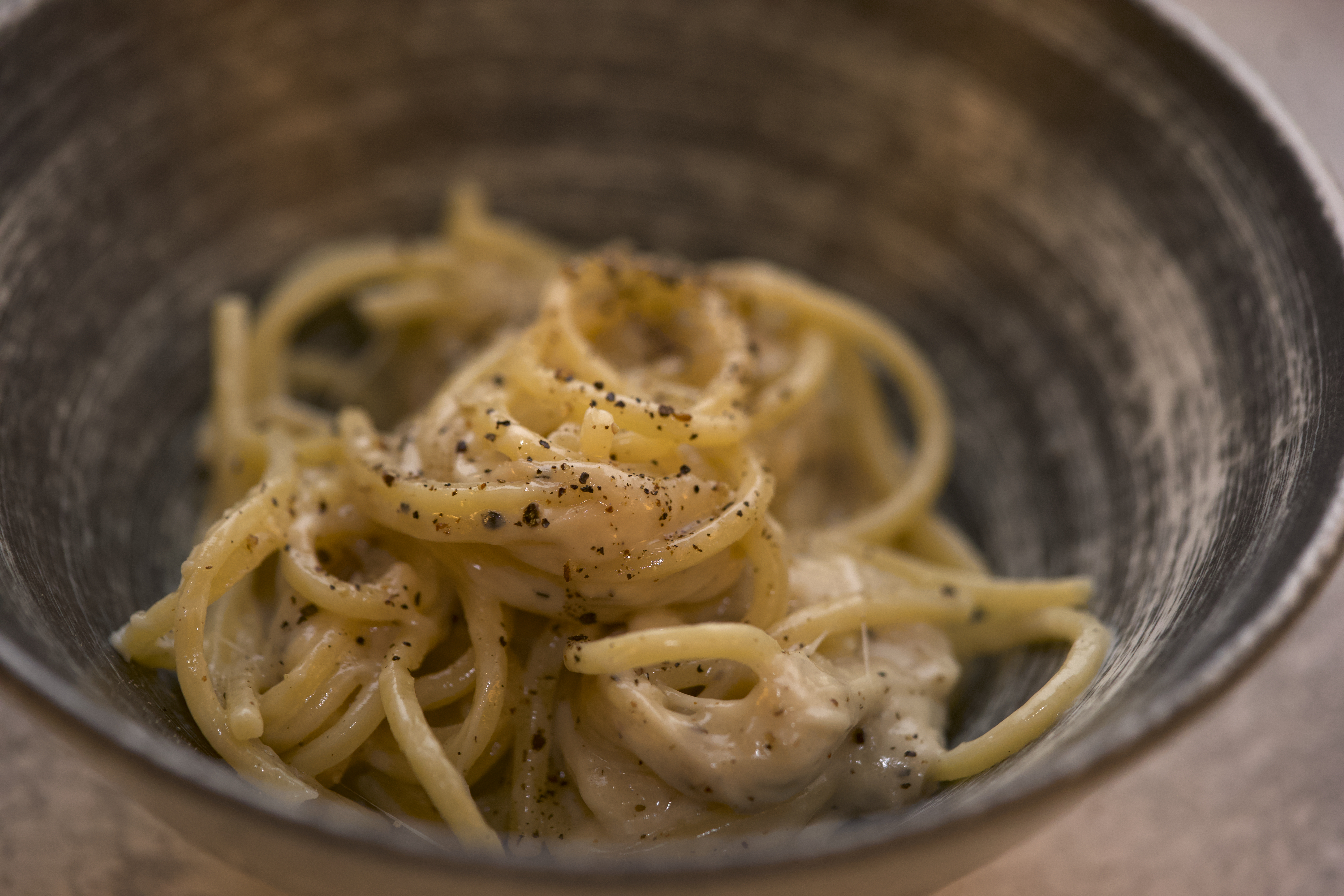
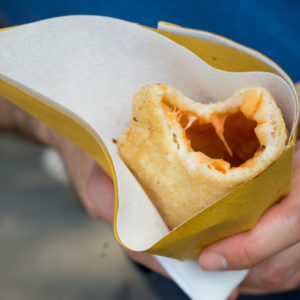
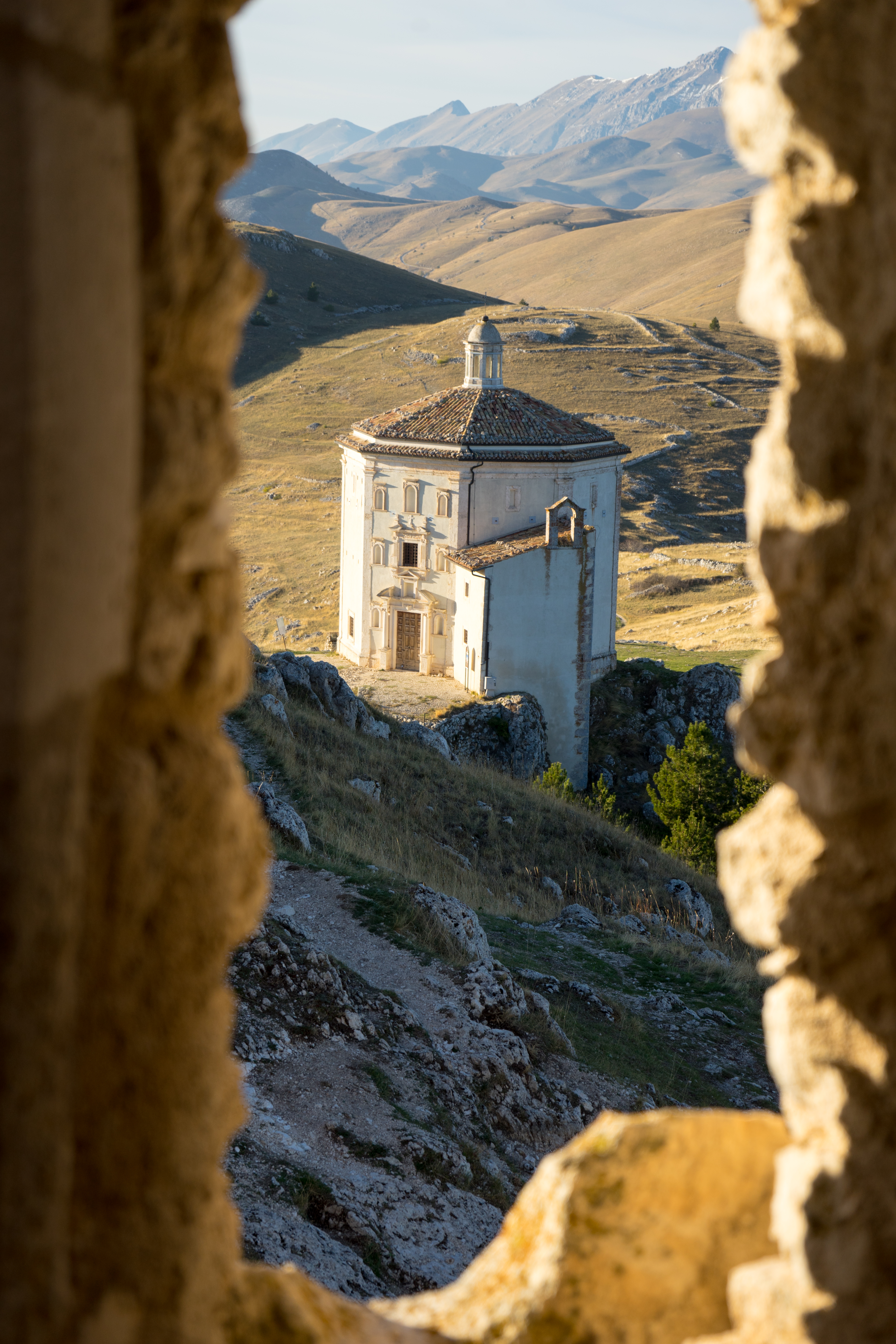
Leave a Reply